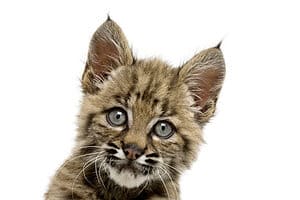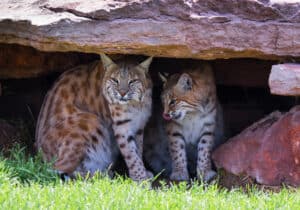If you observe an average house cat closely, you will notice that they have hunting skills such as sharp hearing, quick moves and turns, and light-footed surprise attacks that are not learned throughout their lives but innate to them. Felids or felines are naturally hunters in their natural habitat, so it is not a surprise that domesticated house cats exhibit the same hunting skills. But imagine if these hunting behaviors are exhibited by a cat much larger than domesticated cats? Bobcats are adept hunters, and they are about twice the size of an average house cat. However, Bobcats are way better hunters, and a big help to their impressive hunting skills is the bobcat’s big and sharp teeth that can grab and grip small mammals like raccoons and squirrels.
Bobcats are carnivorous cats found in various environments across North America and southern Canada, including mountainous terrains, forests, grasslands, deserts, and swamps. Bobcats are rarely observed in the wild since these felines like to move, and their strong eyesight and hearing are constantly on the lookout for danger. Like other wild cats, bobcats are excellent predators who stalk their prey. Bobcats are notorious rabbit predators, and they aid in the stabilization of rabbit population cycles, which benefits many predatory species. When rabbits are numerous in an area, they are killed in greater numbers. The bobcat’s sharp hunting skills are further enhanced with its carnivorous canines specifically designed to catch prey.
What Kind of Teeth Do Bobcats Have?

Bobcats have sharp canines they use to grab prey.
©Rejean Bedard/Shutterstock.com
Bobcats, like most mammals, are heterodonts, which means they have a complete variety of teeth that include incisors, canines, premolars, and molars. However, what’s distinct about them is their huge, sharp teeth that most carnivorous wild cat species also have. These sharp teeth are canines designed to grab and bite smaller mammals by their neck. Using their canines, bobcats can shear animal meat into bite-sized pieces, which they swallow whole without chewing.
How Many Teeth Do Bobcats Have?

Bobcats have 28 teeth which include 12 incisors, four canines, eight premolars, and four molar teeth.
©photowind/Shutterstock.com
An adult bobcat typically has a total of 28 teeth unless disrupted by dental issues, to which they are susceptible. Bobcats normally have a dental formula of Incisors 3/3, Canines 1/1, Premolars 2/2, Molars 1/1 = 28. In the formula, each number represents how many teeth bobcats have in each quadrant, which means that on each side of their jaw, they have three incisors, one canine, two premolars, and one molar.
What Do Bobcats Use Their Teeth For?

Bobcats are true carnivores, and their behavior exhibits those of typical predatory cats in the wild. They have a total of four canines in their mouth which they mainly use for hunting. These canine teeth are sharp enough to catch their prey by their neck, grab and grip on them, and pierce through their victim’s flesh. The incisors and canines also work together to cut and tear their prey’s flesh into smaller, digestible pieces. The premolars and molars of a bobcat, collectively called “cheek teeth,” are sharp enough to aid them in cutting and shearing their food before digesting. Unlike most mammals that utilize their molars in chewing and grinding meat, bobcats love to gulp their food down without chewing them.
Besides their razor-sharp teeth accompanied by a ferocious bite, bobcats also have sharp claws that help them kill their prey and defend themselves from predators. Bobcat claws are razor-sharp, and when they are not in use for self-defense, pouncing, or climbing, the claws can be retracted into the paw pads like other Felidae species.
Bobcats are exclusive carnivores, and they eat a diet that includes smaller mammals such as rabbits, rodents, squirrels, and birds. Rabbits and hares make up about 75% to 90% of their diet. These fierce hunters sometimes prefer to prey on animals bigger than themselves too, such as deer. These predatory felines stealthily stalk their prey and then deliver a deathblow with a surprisingly high pounce that often goes beyond 10 feet.
Do Bobcats Have Baby Teeth?
Bobcats are cats, and cats are diphyodont like dogs and humans. This means that bobcats grow two sets of teeth throughout one lifetime, the baby or milk teeth and the permanent set of adult teeth. Bobcat kittens are born with deciduous teeth that are later replaced by permanent teeth.
In a 1988 study of hand-raised bobcat kittens, it was observed that baby teeth began to erupt at 11-14 days of age, and by the 9th week, the deciduous set of teeth was completed. At 16-19 weeks, the subjects’ baby teeth started to fall out, and permanent dentition began erupting. The permanent set of teeth was completed in the bobcat subjects at 34 weeks.
How Strong is a Bobcat’s Bite?
Even though bobcats are only medium-sized mammals, they still have a powerful jaw and a ferocious bite that enhances their hunting and killing skills. It may be hard to believe, but in reality, a bobcat’s bite is even stronger than that of a coyote, dog, fox, lynx, snow leopard, or even a cheetah. A bobcat can generate a bite force of around 548 Newtons, which is strong enough compared to its small size. The bobcat’s canines can bite and pierce deep through their prey and can tear its flesh. Despite their size and faces that look so much like pet cats, bobcats are one of nature’s stealthiest and strongest predators, with a bite that can take down an adult deer.
Though bobcats often prefer rabbits and smaller mammals, when food is scarce, especially during winter seasons, they can try and take down larger prey like deer. A bobcat typically consumes no more than 2 or 3 pounds of flesh per day, and the deer carcass is frequently used as a food source by other species. Bobcats may be average-sized wild cats, but they can sometimes grow much larger, with the largest discovered bobcat weighing up to 52 pounds.
The photo featured at the top of this post is © photowind/Shutterstock.com
Thank you for reading! Have some feedback for us? Contact the AZ Animals editorial team.






